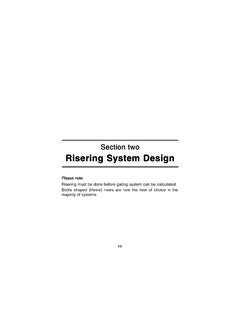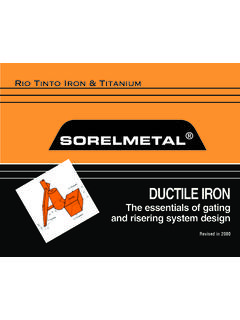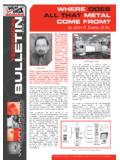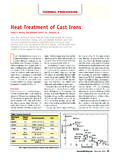Transcription of IO INTO RON & T ITANIUM Sorelmetal
1 RIO TINTO IRON & TITANIUMS orelmetal Suggestionsfor Ductile IronProduction115 INOCULATION OF DUCTILE IRON: WHY AND WHEN?ByPierre-Marie Cabanne and Martin Gagn , Sorelmetal Technical ServicesWHAT IS INOCULATION? WHY SHOULD YOU INOCULATE DUCTILE IRON MELTS?In its liquid state, graphitic iron (lamellar, vermicular or nodular) is a liquid solution in which carbon atoms are dissolved in iron. Without any other alloy additions, an extremely slow cooling rate would result in the precipitation of carbon as graphite, following the Iron-Carbon (graphite) dual phase diagram.
2 However, the solidification of castings deviates from this rule. Under industrial conditions, the combination of the quality of the metallic charge, the melting and treatment of the liquid iron, and the addition of ferroalloys, results in a complex solidification route resulting in an Iron-Cementite-Graphite high cooling rate, which results typically from a thin section size casting, favours the reaction of carbon and iron to form eutectic cementite (iron carbides). This reaction is promoted by the presence of elements, such as Cr and Mn, that are brought into the melt by charge materials (eg.)
3 Steel scrap, certain pig irons,..). These elements, and others (V, Mo, Nb,..), segregate to cell boundaries to form intercellular carbides. Moreover for Ductile Irons, the Mg spheroidization treatment increases the risk of carbide formation by favouring the metastable Iron-Cementite solidification route. (It is worth noting that Keith Millis, one of the inventors of Ductile Iron, was adding magnesium to cast iron to manufacture Ni-Hard type cast iron with a carbidic structure!).The solidification of Ductile Iron is an exogenous process, it is initiated at nucleation sites called nuclei.
4 On these nuclei, carbon atoms precipitate as hexagonal graphite crystals, initially growing in direct contact with the liquid iron. Further, during the solidification process, an austenitic shell crystallizes on the growing graphite spheroids. A solidified cell is then formed. This cell grows and often associates with others to form solid islands floating in the liquid. During this process, the intercellular liquid metal is enriched with certain elements ( Cr, P, Mn, V, Mo.)
5 While the concentrations of others, mainly C and Si, are reduced. Depending on the initial number of nuclei (and then, the number of cells), the concentrations of the deleterious elements increase in the remaining liquid and often results in the formation of complex carbides and of other detrimental phases such as steadite. In order to minimize the enrichment of the cell boundaries in residual elements, one solution is to significantly increase the number of solidifying cells which results in the diminution of the volume of liquid metal between the cells.
6 However, in most cases, this action has to be combined with the careful selection of charge materials containing very low concentrations of residual elements. Sorelmetal , with its exceptional chemical purity level, fulfills this is a well-known fact that a low nodule count (number of nodules) in Ductile Iron is associated with large, poorly shaped spheroids. This detrimentally affects the mechanical properties of the material. Also, the lower the nodule count, the higher the tendency to form pearlite, carbides and micro-porosities.
7 Therefore, inoculation, which has a multiplying effect on the formation of nuclei and solidifying cells in Ductile Iron, is an essential pr ocess step for the production of quality castings. The resulting increased nodule count favours the formation of ferrite and minimizes the occurrence of intercellular carbides and micro-porosities. Moreover, since the inoculating alloy is rich in silicon , it further contributes to the solidification of the iron according to the stable Iron-Graphite phase AND WHEN TO INOCULATE?
8 The efficiency of the inoculation event(s) is very dependent upon on a good quality metallic charge and a robust, well controlled melting process. A metallic charge with low nucleation potential, such as those mainly based on steel scrap, requires more inoculants. Similarly, a non optimized melting process ( long melting and/or holding time, high superheat, holding temperature higher than 1450oC (2650oF)) kills the iron and requires stronger inoculation! To make the inoculation of Ductile Iron more efficient, it is recommended to optimize the charge composition with a significant ratio of Sorelmetal , to rapidly melt the metallic charge and, when liquid, to hold it at as low a temperature as is evaluation of the nucleation potential of the iron is the next step before starting the inoculation process itself.
9 One of the proven techniques to evaluate the nucleation potential is thermal analysis, using the undercooling and recalescenceparameters as indicators (see Suggestions for Ductile Iron Production #103). Chill wedge and plate wedge tests are also utilized to evaluate base iron nucleation potential. Variations should be correlated to variations in castings. A stable nucleation potential in Ductile base iron generally leads to a more uniform nodule count in castings. A Ductile base iron with a high degree of nucleation potential offers a better opportunity to achieve as cast structures free from carbides and can negate the need for expensive salvage heat PROCESSStep 1: PreconditionningPreconditionning describes the addition of a particular inoculant to the clean, deslagged surface of a furnace melt prior to the nodulizing treatment process.
10 This event serves to normalize the nucleation potential of the melt. The inoculant may be high purity graphite, inoculating grade ferrosilicon, or silicon carbide grain. In each case, the addition must be of a size that will dissolve quickly. This is particularly true for silicon carbide as this addition dissolves rather than melts. Typically, an addition of 0,1% or 1 kg per metric ton (2 lb per US ton) is sufficient to enhance the formation of 2: Pre-inoculationAt this stage, an addition of inoculating grade ferrosilicon is made either to the stream of iron filling the treatment ladle, or as part of the alloy package in the treatment ladle.










